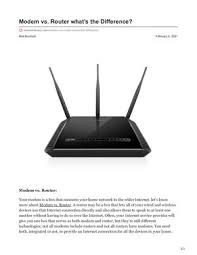Modem
Modem is short for "Modulator-Demodulator." It is a hardware component that allows a computer or another device, such as a router or switch, to connect to the Internet.
Modern modems are typically DSL or cable modems, which are considered "broadband" devices. DSL modems operate over standard telephone lines, but use a wider frequency range. This allows for higher data transfer rates than dial-up modems and enables them to not interfere with phone calls. Cable modems send and receive data over standard cable television lines, which are typically coaxial cables. Most modern cable modems support DOCSIS (Data Over Cable Service Interface Specification), which provides an efficient way of transmitting TV, cable Internet, and digital phone signals over the same cable line.
A modem is there to send and receive internet data and only has a single Ethernet port for sharing that internet connection.
A router is dependent on an Ethernet connection to a modem to share the internet around the home. And a modem-router combines the job of both pieces of networking equipment.
A modem router is simply a single device that combines the functions of a modem and a router.
A modem is a device that connects your home, usually through a coax cable connection, to your Internet service provider (ISP), like Xfinity. The modem takes signals from your ISP and translates them into signals your local devices can use, and vice versa. The connection between your house and the Internet is known as a wide area network (WAN). Each modem has an assigned public IP address that identifies it on the Internet.
